Column: Disneyland will never be completed. Neither will healing the Earth
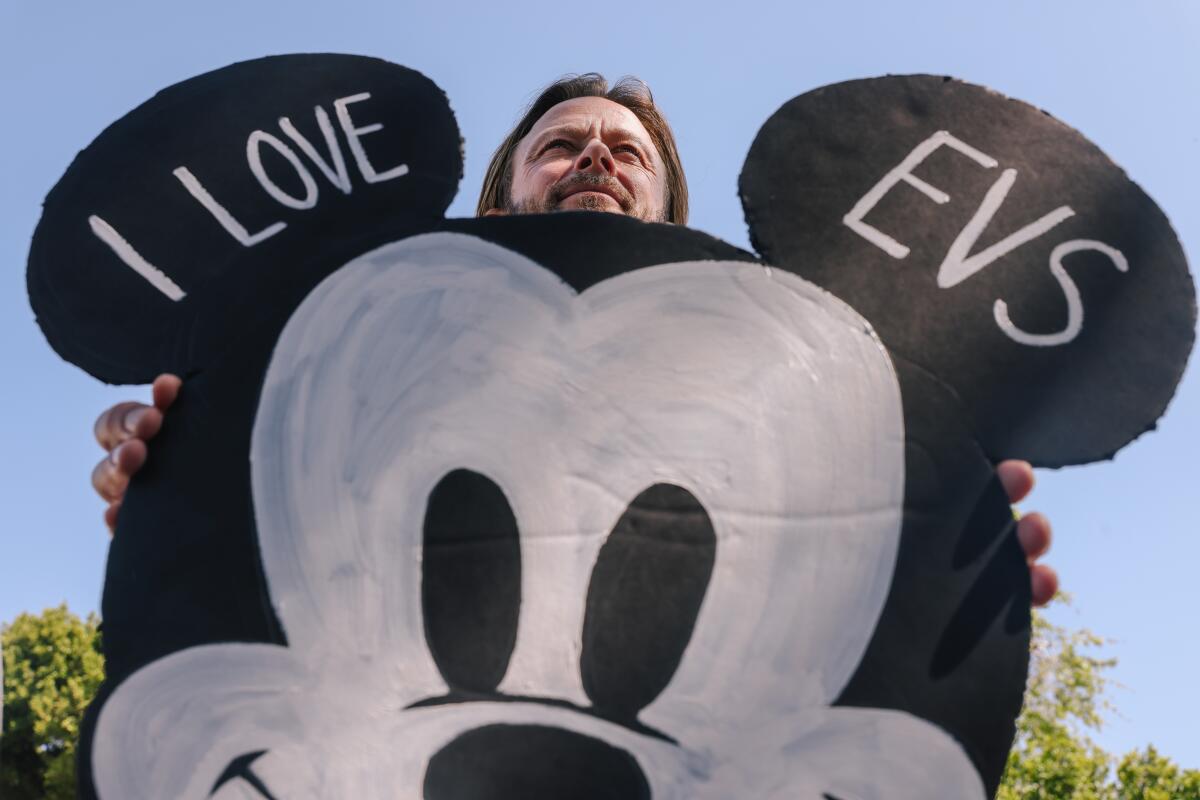
- Share via
It didn’t take much for Eric Swenson to start a chain reaction that in less than two years would prompt the world’s most influential entertainment company to make a powerful clean energy commitment.
Swenson was at Disneyland with his wife, celebrating her birthday. He was startled when he realized that the classic 1955 Autopia ride was as “loud and foul” as ever, with oil-fueled cars spewing lung-damaging, planet-warming gases.
“When I saw Autopia was still like 1,000 lawnmowers running at the same time, I took pictures and sent a note to Paul,” he said.
You're reading Boiling Point
Sammy Roth gets you up to speed on climate change, energy and the environment. Sign up to get it in your inbox twice a week.
You may occasionally receive promotional content from the Los Angeles Times.
That would be longtime electric vehicle advocate Paul Scott. Startled by Swenson’s message, Scott and fellow advocate Zan Dubin filed complaints about Autopia’s air pollution with California regulators, raising questions about possible health dangers to guests waiting in line, and to Disney employees working the attraction, breathing in those fumes for hours on end.
Dubin and Scott also reached out to an L.A. Times climate reporter (me), urging me to write about the opportunity for Disney to convert Autopia to electric cars. I started pressing the company for answers on why it hadn’t done so yet — especially in an area of the park known as Tomorrowland, intended by Walt Disney to showcase technologies that would create a better future.
Lo and behold, Disney quickly promised to ditch gas engines at Autopia. A win for the climate and for our bodies.
Then last week, under continued pressure from a growing coalition of electric car proponents, Disney went further, pledging that Autopia’s new vehicles would be fully electric, not hybrids. The company also promised to stop operating the combustion vehicles by fall 2026 — a much firmer commitment than its initial timeline of “in the next few years.”
On Sunday, Swenson was among two dozen climate advocates who gathered outside Walt Disney Studios in Burbank to cheer the company’s action — and celebrate their own achievement. Dubin led the group in a collective call of “thank you, Disney.”
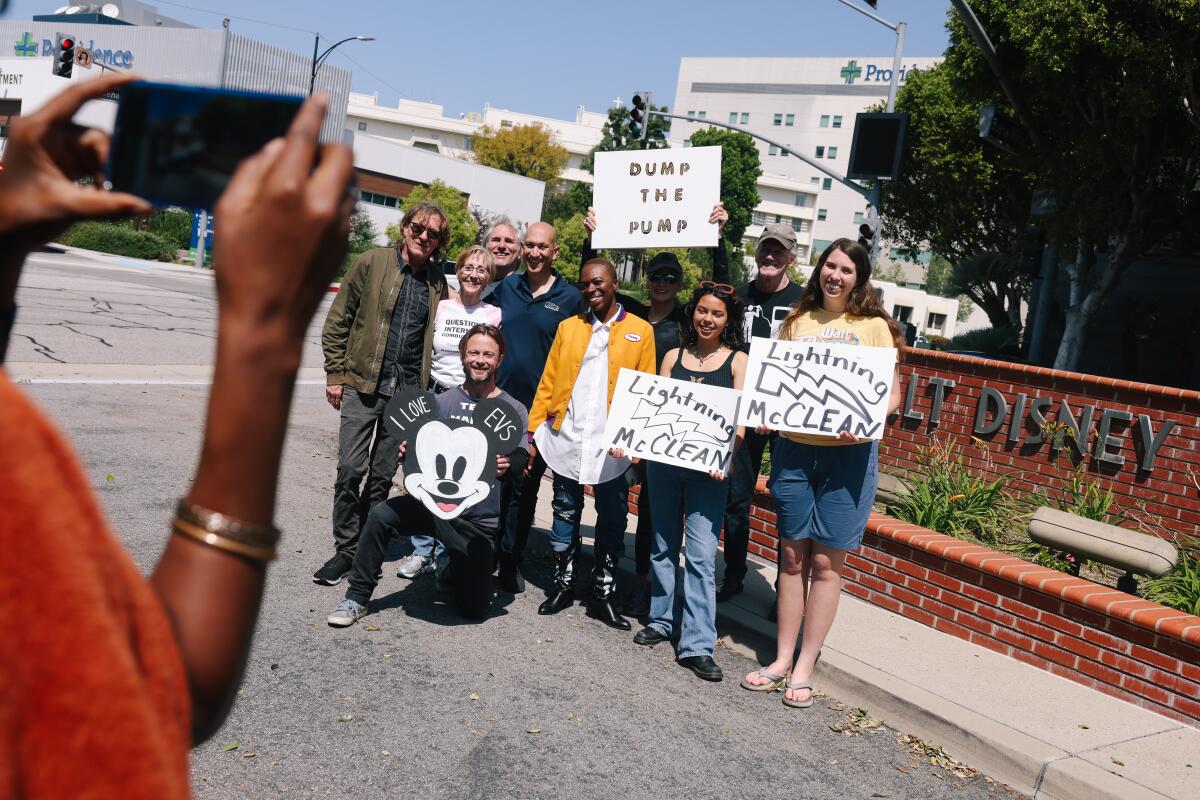
As a climate journalist and lifelong Disneyland obsessive myself, it was hard not to feel inspired.
Several attendees held handmade “Lightning McClean” signs emblazoned with lightning bolts, a reference to Lightning McQueen, the lead character in Disney’s “Cars.” One attendee raised a Mickey Mouse cutout with “I Love EVs” written on Mickey’s ears.
I chatted with veteran EV evangelist Linda Nicholes — who bought one of the first Teslas ever made and pulled up to the rally in a newer Tesla model with the license plate ZAP OIL — and also with 17-year-old Maya, a Santa Monica High School student and one of the youth plaintiffs in a lawsuit designed to force the Biden administration to take stronger action on climate.
“Autopia going electric isn’t going to fix all of the world’s problems,” said Maya, who’s been advised not to share her last name for safety reasons. “More than anything it’s a symbolic change. And it’s showing that we are transitioning away from the fossil fuel industry, and just showing the world that hey — this is not OK for workers. This is not OK for kids going to Disneyland.”
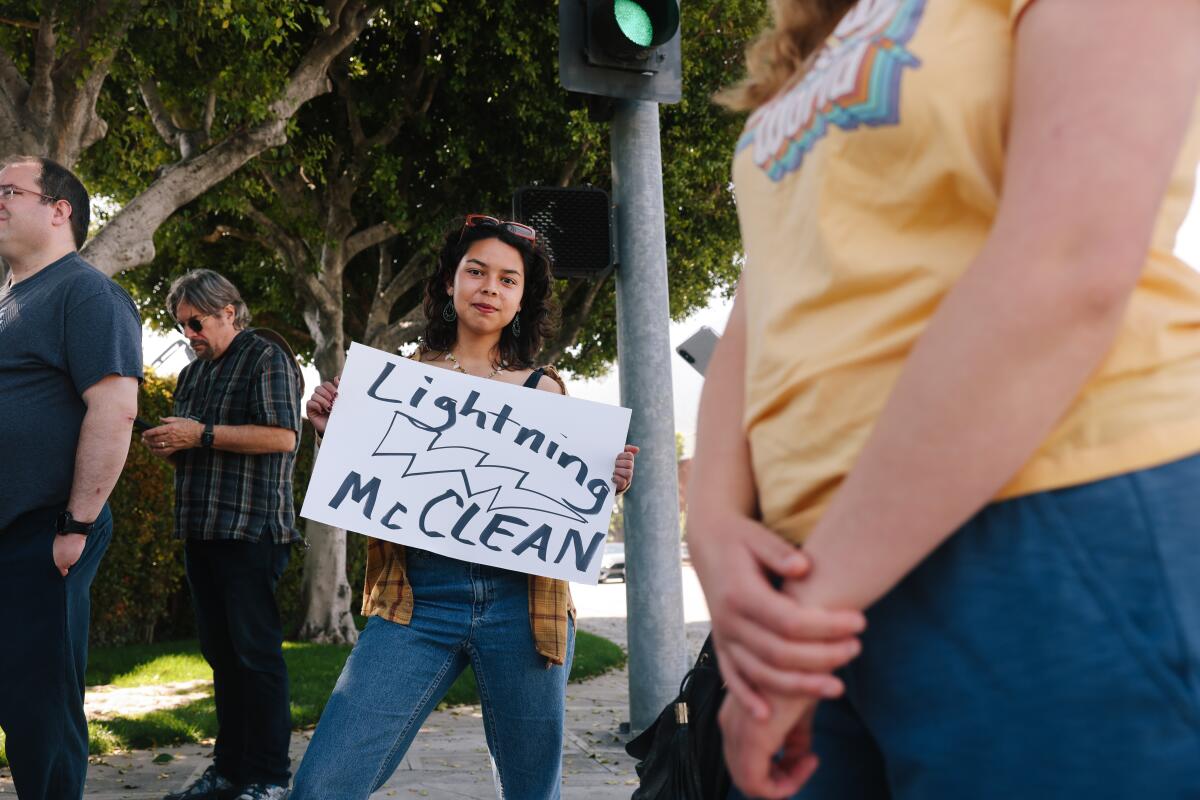
Several people referenced a well-worn Margaret Mead quote: “Never doubt that a small group of thoughtful, committed citizens can change the world; indeed, it’s the only thing that ever has.” It’s a cliche, but it’s true. Sunday’s rally was proof.
And although climate change is far too broad a challenge for any one campaign or law or regulation to do more than help a little bit, pushing Disney to act is a pretty effective strategy. The company’s movies, theme park attractions and characters can become global cultural touchstones, with songs and stories such as “It’s A Small World” and “Black Panther” going beyond entertainment and sharing important messages about world peace, diversity, inclusion and more.
An electric Autopia will hopefully do the same, inspiring kids and their parents to embrace a future of mobility fueled by climate-friendly solar and wind energy, rather that the planet-wrecking oil that the ride has been hawking for nearly 70 years.
But as thrilled as the climate advocates gathered in Burbank on Sunday were, they want more.
They want to see Disney commit to electric cars at the Autopia-like attractions at Florida’s Walt Disney World and Disneyland Paris too. Dubin in particular said she’ll keep pressing California officials to hold Disney accountable for the noxious fumes that Autopia continues to spew in Anaheim, as the attraction’s gas engines run for up to two and a half more years.
“We want [air quality] measurements,” Dubin told me. “I don’t want to do anything without data.”
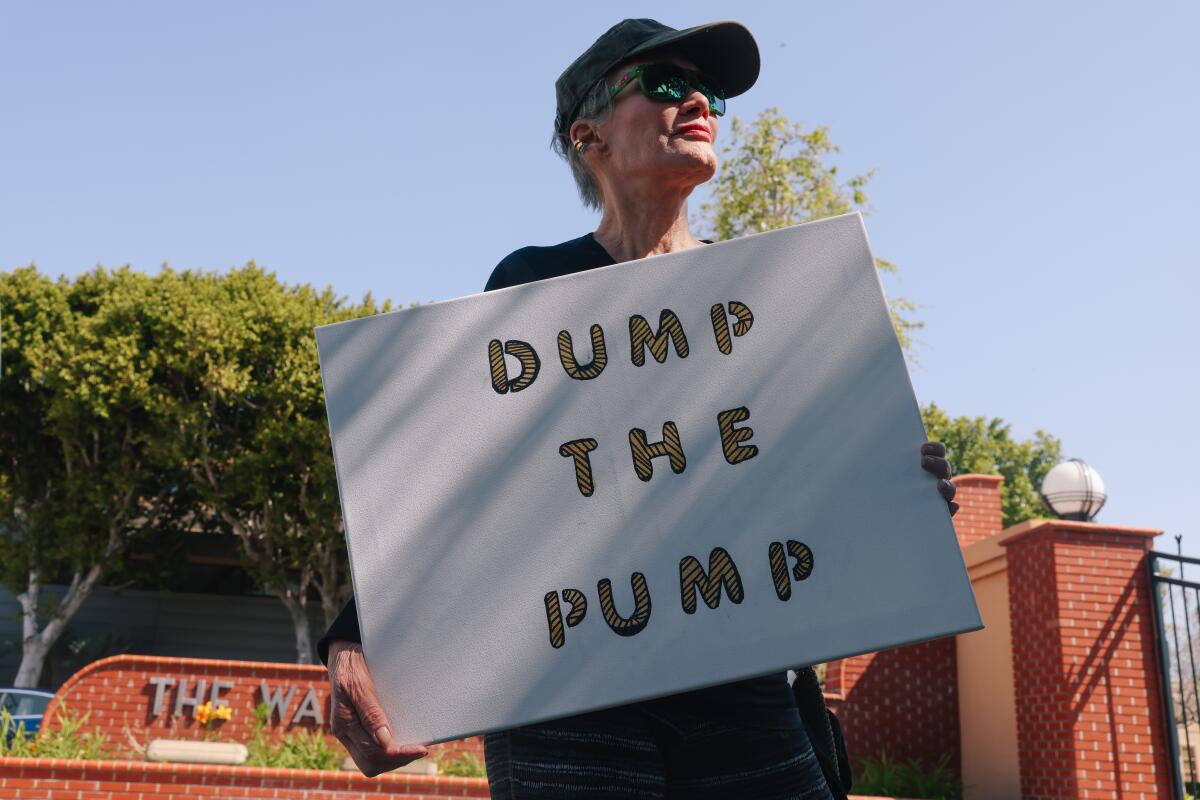
I have my own ideas for other steps Disneyland could take on climate, as I shared in a column a few weeks ago.
But even if the company doesn’t adopt my personal vision for a Tomorrowland reoriented around clean energy and sustainability, Disney could pepper its parks with climate-friendly flourishes that entertain and enlighten — and enhance the guest experience. Flourishes such as solar-panel shade structures that keep guests cool waiting in line, and gas-free induction stoves that clean the air in restaurants, and permeable pavement that makes Main Street, U.S.A. easier to navigate when it rains.
As Walt Disney said, “Disneyland will never be completed. It will continue to grow as long as there is imagination left in the world.”
Fortunately, there’s a lot of imagination left in the world. We’ll need it to solve the climate crisis — or limit the crisis, I should say. There’s already so much extra carbon in Earth’s atmosphere that the planet will probably keep heating up for many years even if we manage to ratchet down emissions close to zero with lightning speed.
But just because we can’t avoid all harm doesn’t mean we shouldn’t do as much good as we can.
That much was clear listening to Jordan Howard before the rally.
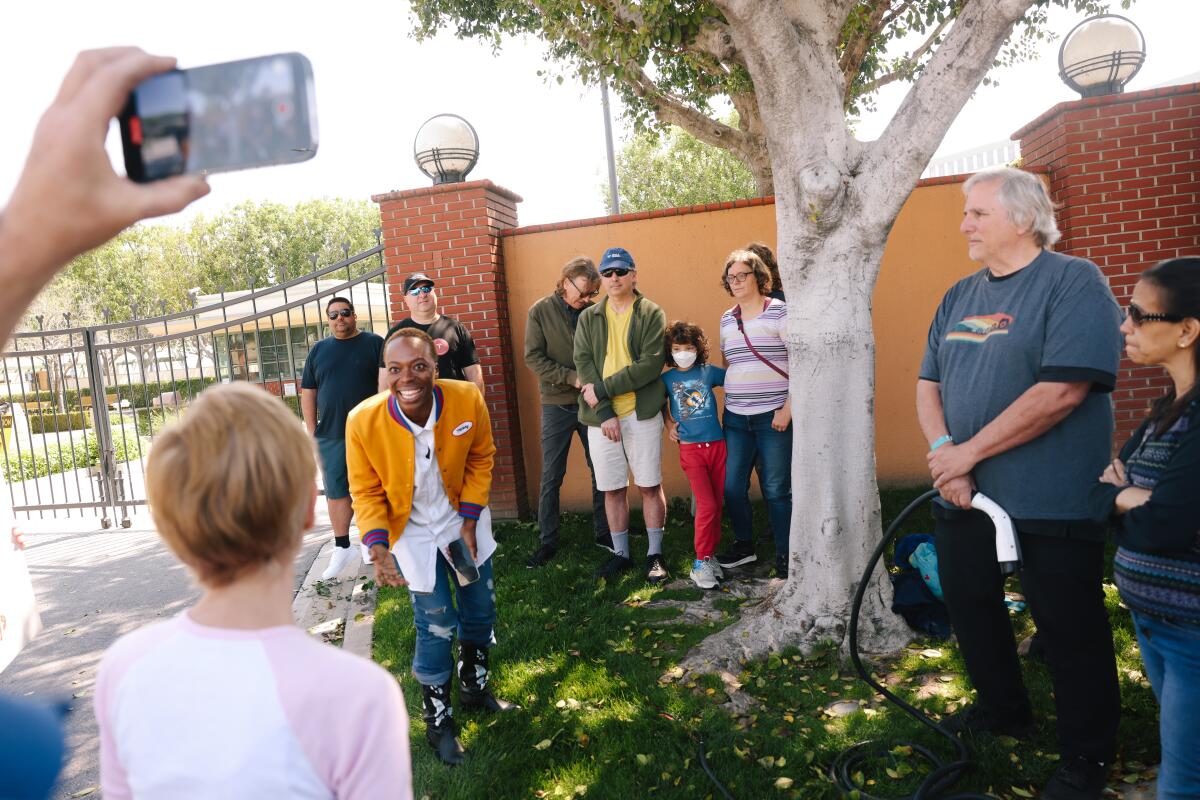
Howard, the founder and chief executive of ShftSpace, advises companies and other organizations on sustainability and socially conscious choices in their supply chains and community engagement. Clad in a whimsical Tokyo Disney jacket that she bought at Goodwill, the 32-year-old South Central L.A. resident told me how much harder her life has become since contracting long COVID and later being diagnosed with lupus, which researchers have found can be caused at least in part by environmental factors.
Howard has also “watched more Disney than any other type of television,” from Zendaya on “Shake It Up” to classics like Mickey, Goofy and Cinderella. To her, companies “as large and as imaginative” as Disney need to be trendsetters, not dinosaurs.
“I was born in raised in L.A. Fantasy is life, fantasy is love,” she said. “But fantasy also has to be truthful and honest. And fantasy should always keep up with innovation and what’s possible.”
Once in a great while, we might look to the past for innovations and inspirations.
Before personal cars fueled by petroleum became our dominant mode of transportation, the L.A. area had a thriving system of electric streetcars called the Red Car trolleys. I was reminded of that after Sunday’s rally, when I took a half-hour stroll to Griffith Park’s Travel Town Museum, crossing the Los Angeles River to explore a lovely railroad history exhibit and picnic spot.
Hidden among the old trains was a waiting shelter from the Rio Vista Station on the Red Car’s L.A. to Van Nuys line, circa 1920.
I’m bringing this up because it made me think about Disney.
At Disney’s California Adventure Park in Anaheim, there’s a wonderful Red Car Trolley ride based on the real-life originals, running up and down the park’s 1920s-themed Buena Vista Street — the name a nod to the location of Walt’s studio, where the victorious climate advocates gathered on Sunday. Disney actually released a movie in the 1980s, “Who Framed Roger Rabbit,” dealing with the elimination of L.A.’s electric streetcars to make way for freeways. There’s a great ride inspired by the film at Disneyland.
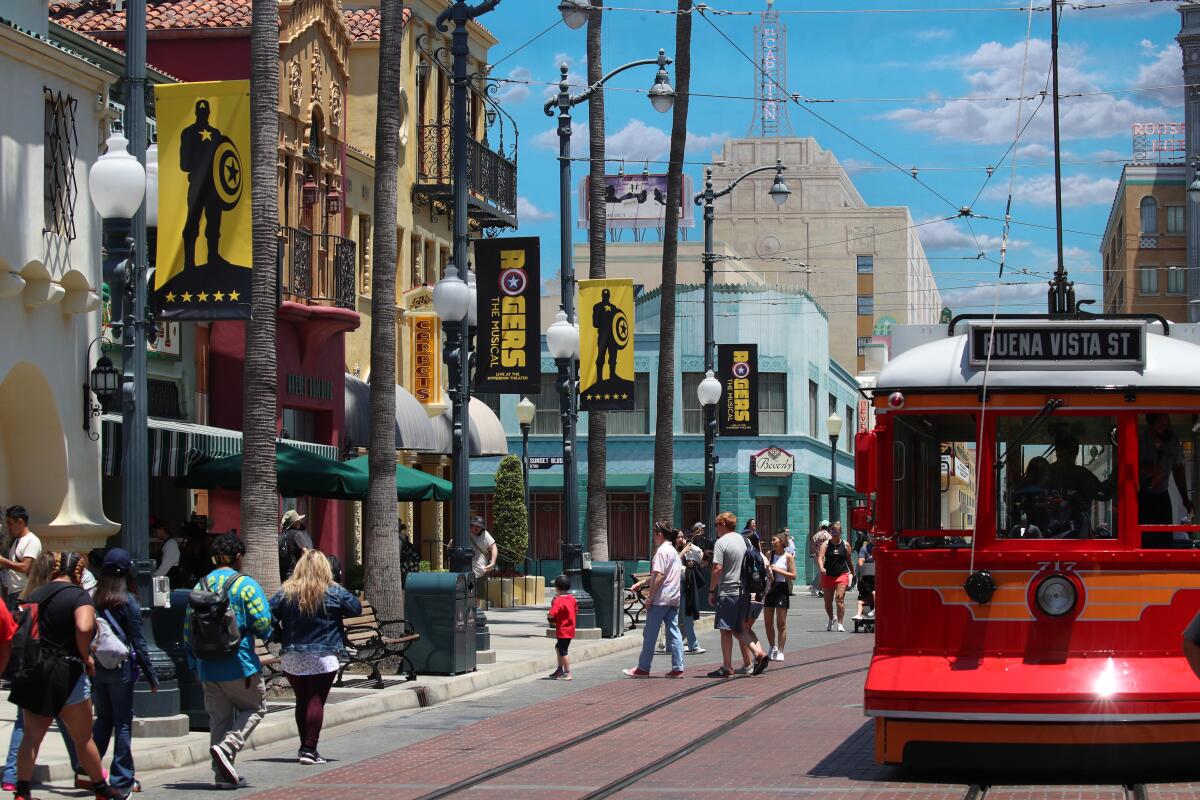
And as most climate advocates will tell you, electric cars are crucial for replacing fossil fuels, but they’re not enough.
To slash climate pollution fast enough to avoid catastrophic climate damage — while also lessening other injustices caused by oil combustion and freeway construction — we also need rebuild our cities around people, not cars. That means fewer parking spots and more public transit, bike paths, walkways, parks and green spaces that provide protection from heat and flooding.
Disney doesn’t need to start displaying radical messages about the end of cars. A sign or two at California Adventure explaining the history of the Red Car trolleys and alluding to the value in moving back toward electrified public transit would be great.
Like Walt said, Disneyland will never be completed. And neither will the work of healing the Earth. There’s all that carbon built up in the atmosphere, and the decades or centuries it’ll take us to get global temperatures under control, should we succeed in that task. Beyond that, we’ll have other problems to keep grappling with. Microplastics. Forever chemicals. Who knows what else.
It didn’t escape my attention that no one at Sunday’s rally bothered to mention that it was taking place the day before Earth Day. Because — get ready for another cliche — every day is Earth Day. So long as we have sun and wind and soil and sky...
Sounds like a Disney song. Alan Menken, get on that?
OK, here’s what else is in the news:
WATER IN THE WEST
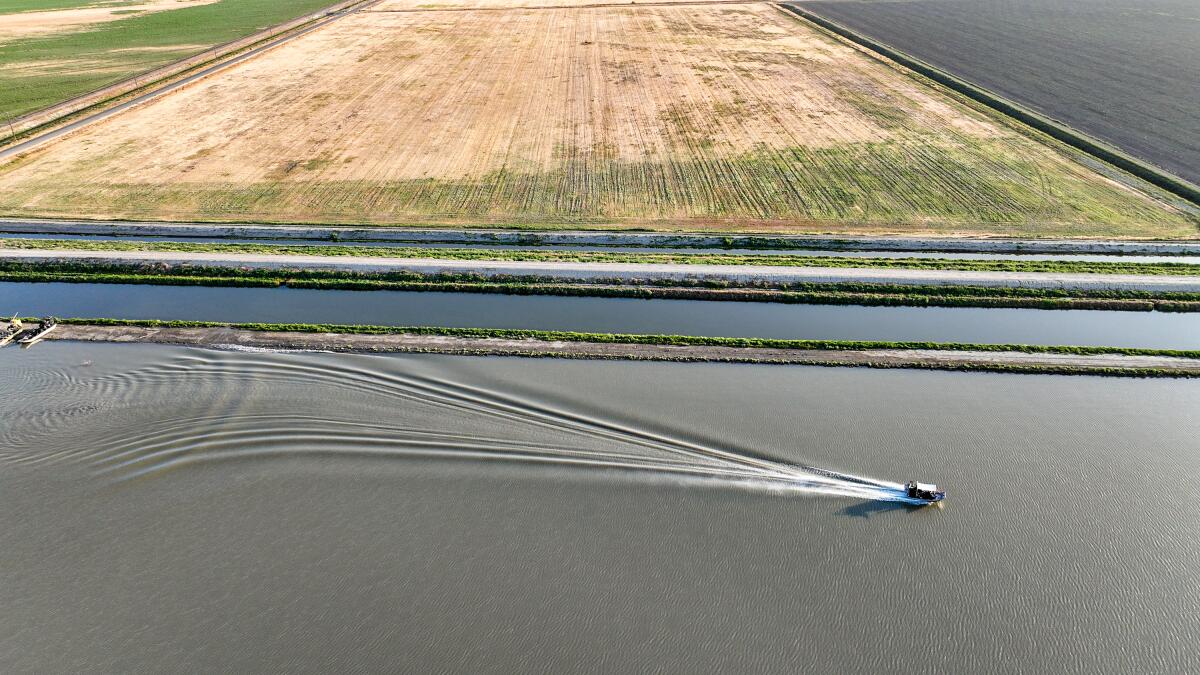
For the first time, California regulators are cracking down on farmers overpumping groundwater, under a law passed a decade ago. Growers in the San Joaquin Valley’s Tulare Lake subbasin will have to report how much they pump and pay fees, in order to lower the risk of household wells running dry, my L.A. Times colleagues Ian James and Jessica Garrison report. Farmers in other parts of the San Joaquin Valley could be next. Ian also wrote about damage inside Glen Canyon Dam that could force federal officials to cut back on water deliveries from Lake Powell to California, Nevada and Arizona, if engineering fixes aren’t found.
“This river is our church, and that salmon is the cross on that church.” So said Kenneth Brink, vice chair of the Karuk Tribe, during the first major release of coho salmon into the Klamath River since the removal of four dams near the California-Oregon state line began last year. Ian James covered the historic occasion. L.A. Times columnist Michael Hiltzik, meanwhile, made the case that it’s not just drought and climate change decimating California’s salmon industry — too much deference to farmers is also to blame. State officials also voted to protect Southern California steelhead trout as an endangered species, Ian reported.
It only took 24 years after “Erin Brockovich” hit theaters, but California finally has limits on cancer-causing chromium-6 in drinking water — limits that state officials acknowledge won’t fully protect our health. The Times’ Ian James has the details, writing that long-term exposure to chromium-6 “has been linked to gastrointestinal cancer, reproductive harm and damage to the liver and kidneys.” In other water contamination news, more than a dozen California water providers are suing “forever chemical” manufacturers in hopes of forcing them to pay for cleaning up drinking water, Reuters’ Clark Mindock reports. Seriously, there’s toxic stuff everywhere. Just one more example: Toxic dry cleaning chemicals in soil are disrupting plans for an elementary school expansion in Santa Monica, my L.A. Times colleague Tony Briscoe reports.
POLITICAL CLIMATE
California finally has rules to protect indoor workers from extreme heat, as ordered by lawmakers in 2016 — unless you work in a prison, in which case you’re out of luck, because state finance officials say complying with the rules would be too expensive. That was the compromise reached to get heat protections finalized ahead of this summer, so that the California Department of Finance wouldn’t torpedo the rules for everyone, The Times’ Suhauna Hussain and Hayley Smith report. In related news, The Times’ Alex Wigglesworth wrote about a new study quantifying how much worse the 2021 Pacific Northwest heat dome and wildfires were because of climate change. (Short version: A lot worse.) And speaking of fires, Laurence Darmiento writes that even more home insurance companies are fleeing California as global warming drives worsening blazes.
Gov. Gavin Newsom has an ambitious new plan to utilize more than half of California’s 100 million acres fighting climate change, through strategies such as beneficial fire, carbon storage and groundwater replenishment. Details here from The Times’ Hayley Smith. At the federal level, meanwhile, the Washington Post’s Maxine Joselow reports that the Biden administration just finalized a rule that will put conservation, recreation and solar and wind energy development on equal footing with resource extraction on America’s public lands for the first time. Former President Trump, by contrast, wants to ramp up oil and gas drilling while kicking out immigrants should voters return him to office. But in the oil and gas fields of the Permian Basin in New Mexico and Texas, immigrants make up much of the workforce, USA Today’s Lauren Villagran reports.
As California faces a massive budget deficit, one of the deepest climate cuts proposed by Gov. Gavin Newsom would hit a program designed to help low-income homes replace gas space and water heaters with clean electric appliances. “The real goal from our perspective was to make healthy homes,” Alex Jasset, director of energy justice at the advocacy group Physicians for Social Responsibility Los Angeles, told Capital & Main’s Aaron Cantú. “To go beyond climate emissions reductions, and to think about things like indoor air pollution.” We’ll have to see how the program weathers the budget process. My L.A. Times colleague Mackenzie Mays wrote more broadly about which pilot programs Newsom has proposed scaling back or eliminating.
THE ENERGY TRANSITION
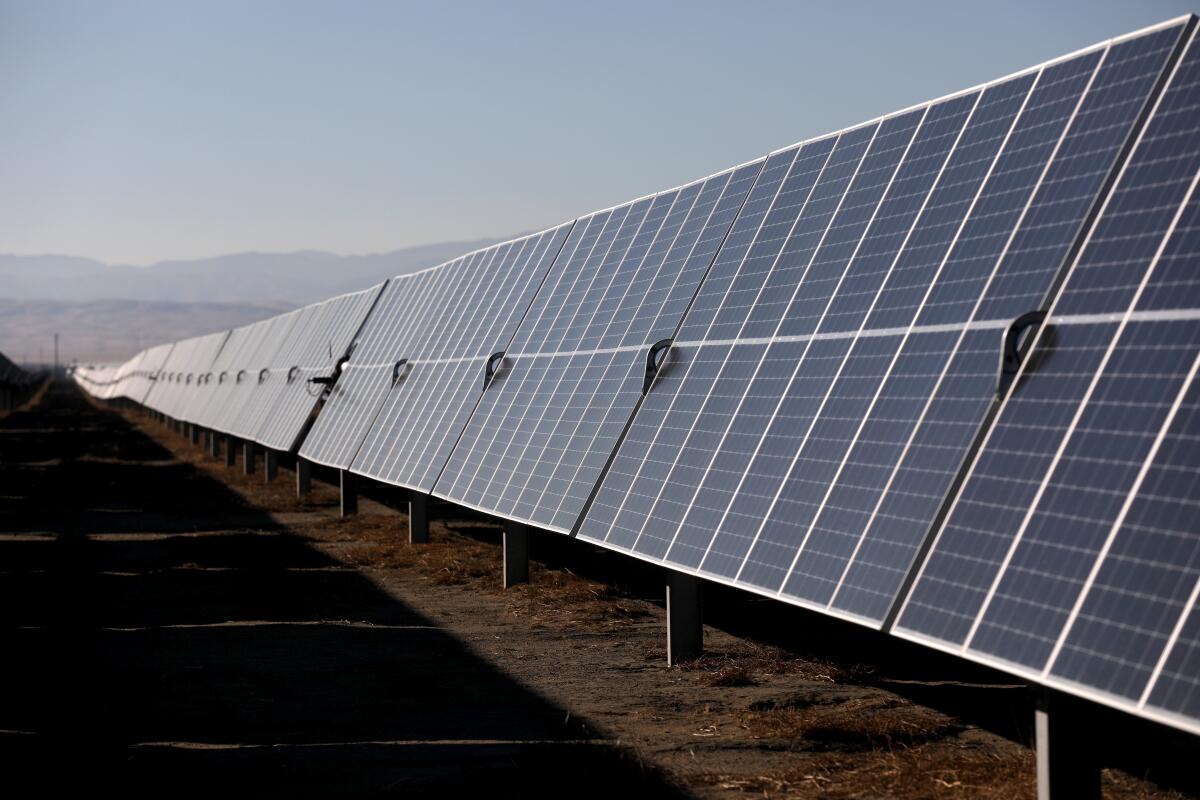
Fascinating new research finds that people living near solar farms generally like them — except when the solar farms are really big, in which case neighbors tend to hate them. Inside Climate News’ Dan Gearino wrote about the survey, which offers a valuable-if-incomplete look at what people do and don’t mind about solar developers moving in next door. I was also struck by this story from the Desert Sun’s Janet Wilson about growing calls for President Biden to establish Chuckwalla National Monument in the California desert. It’s interesting to see Southern California Edison and solar industry representatives join the coalition now that pieces of the proposed monument have been carved out to create room for solar development and power lines.
Hundreds of thousands of dark money dollars are flowing into typically sleepy elections in California’s Imperial County as the Salton Sea lithium boom gets underway, raising questions about where all that money is coming from. Fortunately, the Desert Sun’s Janet Wilson is asking those questions. Lithium is a key ingredient in electric car batteries. But at least right now, the electric vehicle market is facing some trouble, as seen in Tesla’s recent layoffs, per my L.A. Times colleague Russ Mitchell. Longer term, some American politicians worry the U.S. is falling behind China in the global race to dominate EV sales, The Times’ China correspondent, Stephanie Yang, reports. And lest we forget there are other replacements for gasoline besides electric cars, check out this great story by Andrew J. Campa about an electric bike loan program coming to South L.A.
The Biden administration released a detailed plan for how to move more renewable electricity through the grid without building quite so many new power lines — and, crucially, how state officials can push utility companies, which make a lot of money building new power lines, to adopt these technologies. Canary Media’s Jeff St. John has a great rundown. That said, we’ll definitely still need a lot of new transmission lines to support more solar and wind power. So it’s newsworthy that a federal judge has blocked the latest effort by Native American tribes and conservationists to stop a $10-billion line being built through New Mexico and Arizona, which will help get wind energy to California, as the Associated Press’ Susan Montoya Bryan reports.
AROUND THE WEST
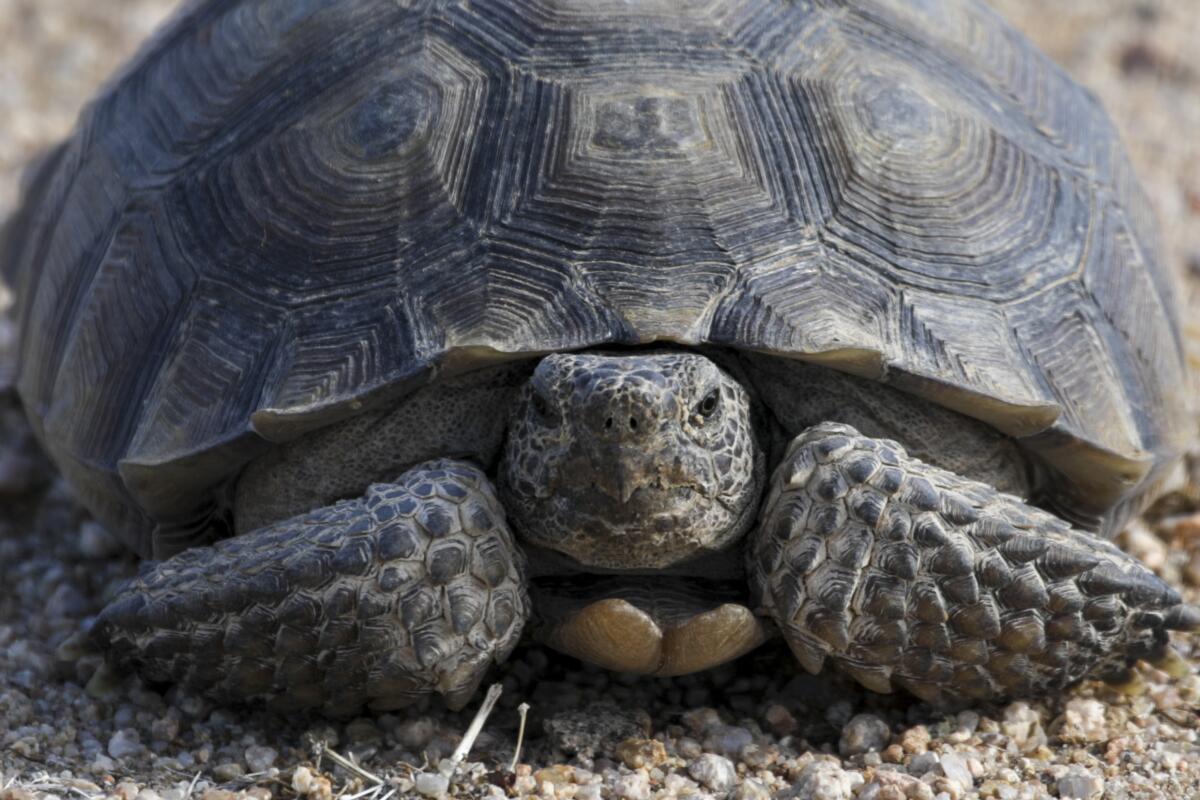
It’s official: Desert tortoises are now an endangered species in the Golden State. Conservationists have urged the state’s Fish and Game Commission to give the official state reptile full protections under the California Endangered Species Act, given that the beloved creature faces a long list of threats — including urban sprawl, drought and wildfires — several of which are made worse by the climate crisis. The agency has now granted that request, The Times’ Summer Lin reports. In other wildlife news, the closest living relatives of the Xerces Blue butterfly — the first U.S. butterfly species to go extinct due to human development — are being reintroduced at the Presidio of San Francisco, as the Associated Press’ Haven Daley and Olga R. Rodriguez write. The Washington Post’s Dino Grandoni, meanwhile, has a wonderful story out of the San Diego Zoo about saving black-footed ferrets.
Climate change-fueled storms or fires could be worsening the rockfalls that keep shutting down a section of California’s Highway 1. That’s according to this story by my L.A. Times colleague Grace Toohey. As Highway 1 keeps crumbling, the California Department of Transportation is trying to rebuild the roadway to make it more resilient to climate change, The Times’ Ryan Fonseca writes. The major climate concern along the coast is sea level rise. For some scary lessons about what the future might have in store, check out this illuminating video from The Times’ resident puppeteer, Safi Nazzal, starring his sheep puppet, Judeh. They took a trip to Tampa and explored how rising waters are affecting the Gulf Coast.
If we want to reverse global warming, we’ll need to pull carbon from the atmosphere — but that can’t be an excuse for not rapidly slashing fossil fuel production. That was a key takeaway from this story by my L.A. Times colleague Hayley Smith, who visited the United States’ first commercial direct air capture facility, in California’s San Joaquin County. “We need to do this all around the world,” said Vikrum Aiyer, head of public policy for Heirloom, the California-based company that owns and operates the direct air capture facility. The good news, he said, is that “CO2 removed anywhere is CO2 removed everywhere.”
A FEW MORE THINGS
First off — thank you to everyone who came to the L.A. Times Festival of Books over the weekend! It was so lovely meeting and talking with many of you at our climate change panels. Let’s do it again next year, and the year after that, and the year after that...
Thanks also to everyone who tuned in to my live discussion with Dusty Sage, founder of Disney fan site MiceChat, about all things Autopia and Tomorrowland! It was awesome walking around Disneyland and talking clean energy. The video is here.
Another video, if you’re interested, is this great explainer for how and why to get plastic out your life, starring L.A. Times reporter Susanne Rust and produced by Jessica Q. Chen and Maggie Beidelman.
Last but certainly not least ... Legendary environment reporter Louis Sahagún has retired after nearly 50 years with The Times. It’s an honor to have worked with him. For a look back at his incredible career, check out this tribute video from L.A. Times Today.
This column is the latest edition of Boiling Point, an email newsletter about climate change and the environment in California and the American West. You can sign up for Boiling Point here. And for more climate and environment news, follow @Sammy_Roth on X.
Toward a more sustainable California
Get Boiling Point, our newsletter exploring climate change, energy and the environment, and become part of the conversation — and the solution.
You may occasionally receive promotional content from the Los Angeles Times.




